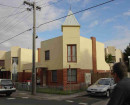GALATEA CO
GALATEA ROAD NEWTOWN, GOLDEN PLAINS SHIRE
-
Add to tour
You must log in to do that.
-
Share
-
Shortlist place
You must log in to do that.
- Download report
Statement of Significance
This record has minimal details. Please look to the right-hand-side bar for any further details about this record.
-
-
GALATEA CO - History
Contextual History:History of Place:
Heritage Inventory History of Site:
SCARSDALE GREAT EXTENDED GOLD MINING COMPANY at Brownsvale Scarsdale (may be the same company as the Scarsdale Extended given the reports of December 1865 and March 1866)
SCARSDALE EXTENDED COMPANY in March 1864 this mine is said to be at Springdallah, Scarsdale and in June 1864 located in the Brownsvale pre-emptive right
GALATEA COMPANY
1861: Mr. Browne sold part of his land to the Scarsdale Extended Company, which was later known as the Galatea Mine.
10.1861: brought 960 acres for 10,000 pounds and sold to the New Company for 27,000 pounds on terms of 10,000 pounds down, 10,000 pounds in 5 years out of gold and 7500 pounds worth of shares.
1862: claim taken up
10.02.1863: the Scarsdale Great Extended Company, Scarsdale, on private property has its shaft down 106 feet or 36 feet below the first rock; the company has purchased 300 feet of 13 inch pumps from the National Co. on the Durham Lead for £575; and from Mr. McFarlane of Melbourne a splendid steam engine 23.5 inch cylinder of 45 hp, with two hand made boilers 26 feet by 6 feet 6 inches, which will be delivered within 14 days and cost £1124; tenders will be called for the erection of the plant.
24.04.1863: the Scarsdale Great Extended Company, Scarsdale, on private property paid £1340 to Ormiston, Law and Furnie to erect a 20 inch engine and a 23.5 inch engine, three boilers 20 by 6.5 feet, a 60 foot brick chimney; the 300 feet of 13 inch pipe purchased from the National Co. was manufactured by Hunt and Opie of the Victoria Foundry at Ballarat.
10.1863: have got through the first rock and sinking will be quicker provided water does not inhibit sinking.
03.1864: are still in rock.
06.1864: depth of shaft is 230 feet, intend opening out at 284 feet.
09.1864: opened out at a depth of 284 feet.
11.1864: new 3 compartment main shaft, 9 feet by 3 feet 6 inches, down 293 feet and first rock water heavy; 13 inch and 9 inch pumps operating with a 6 foot 6 inch stroke pumping 30,000 gallons per hour; the shaft was sunk initially with 2 draw lifts; now has a 13 inch plunger to 200 feet and a drawlift for the remainder; using a 23.125 inch by 46 inch steam engine for pumping with heavy spur and pinion wheels in the connecting gear, a 16 inch by 36 inch steam engine for winding, 3 boilers: 2 x 20 feet by 6 feet 6 inches and 1 x 20 feet by 6 feet, Round’s patent 3 strand flat chains, and a capstan for lowering pumps
12.1864: still driving for the gutter in the direction of the creek.
03.1865: main drive is several hundred feet long; still have not broken into the gutter.
06.1865: several hundred feet away from the shaft and still driving for the gutter.
12.1865: operations have not been resumed, causing the Golden Lake to suspend operations.
03.1866: still has not yet recommenced; also preventing the Golden Lake from sinking their shaft.
26.06.1866: new 16 inch pumps fixed; to start pumping shortly
06.1866: have their lifts in working order; have a double column baling an immense quantity of water; the mine should soon be dry.
28.08.1866: water down 34 feet; 71 feet to go; pumps working 11 x 6 foot 6 inch strokes per minute
09.1866: after baling for some weeks have ceased for a while.
12.1866: idle; water from this claim has forced operations to cease in the Golden Lake, Golden Horn and the Atlas.
15.01.1867: capital exhausted; pumping suspended about 14 weeks ago
26.02.1867: 3 compartment shaft, 9 feet by 3 feet 6 inches, down 293 feet with main drive in 1150 feet; a 23.125 inch by 46 inch steam engine for pumping, with heavy spur and pinion wheel connecting gear; a 16 inch by 36 inch steam engine for winding, 3 boilers: two 20 feet by 6 feet 6 inches and one 20 feet by 6 feet, Round’s patent 3 strand flat chain, 17 inch and 13.25 inch pumps, lifts working 10 inches and 13 inches respectively, and pumping 50,000 gallons per hour, capstan for lowering pumps
14.09.1867: water lowered 7 feet in shaft; problems resolved. Entire company, on which £40,000 expended, sold to Mr. Nixon for £13, plus the mortgage of £15,000.
09.1867: continually baling
09.1868: reached the gutter.
12.1868: yield for the quarter 320 ozs 17 dwt 7 gr
03.1869: yield for the quarter 842 ozs 1 dwt 2 gr
12.1869: yield for the quarter 1751 ozs 8 dwt.
03.1870: yield for the quarter 1637 ozs 12 dwt 13 gr
06.1870: yield for the quarter 2268 ozs 10 dwt.
09.1870: yield for the quarter 1916 ozs 10 dwt.31
12.1870: yield for the quarter 2057 ozs 10 dwt 6 gr
03.1871: yield for the quarter 1768 ozs 4 dwt.
06.1871: yield for the quarter 1978 ozs 14 dwt.
09.1871: yield for the quarter 1917 ozs 14 dwt.
12.1871: yield for the quarter 1605 ozs 16 dwt gr.35
1871: average yield per fortnight for the year was 270 ozs.
03.1872: yield for the quarter 1563 ozs 14 dwt
06.1872: yield for the quarter 1573 ozs.
31.10.1872: worked on tribute which proved to be a great experiment giving good wages to the tributers, moderate dividends to the shareholders and opening up large areas of permanent wash; raised 132,293 trucks of wash and 6375 trucks of mullock; yield of 3183 ozs 16 dwt 3 gr.
12.1872:yield for the quarter 1098 ozs.
1872: average weekly yield for the year was 85 ozs.
21.01.1873: starting a new tribute party next week.
03.1873: yield for the quarter 559 ozs 2 dwt.
09.1873: yield for the quarter 229 ozs 3 dwt.
10.1868 to 09.1873: recorded production of 26,170 ozs 17 dwt 19 gr (or 814.025 kg).
1873:the mine started to fail during this year and was purchased by Armstrong and Party for £2,700; blocks were let on tribute, but they gave poor returns to the tributers.Heritage Inventory Description
GALATEA CO - Heritage Inventory Description
This is a very large site from which large quantities of quartz wash have been removed. Despite these removals the site still retains large quantities of mullock and quartz wash. The site is cut in two by a track. The largest heap is on the east side of the track and has several levels cut when material was being removed. It covers an area of approximately 120m by 50m and its maximum height varies from 5-7 m. It is a very disturbed heap. North of this heap is a large area approximately 100m by 100m covered in slum and fine gravel. The other heap of quartz wash is on the west of the track opposite the other heap. It is 80m by 30m by 3m high. The depression, where the shaft was, is located at the south west end of this second heap. Thisdepression, runs east and part of it appears to be the remains of a pump bob pit. Immediately west of the depression is another, narrow, depression running west from which several cut off iron rods or holding down blots are protruding. There are a few more holding down bolts and some piles of rocks further west of this depression. North of these depressions are the remains of the settings for three boilers covering an area 9m by 6m. The remains of the boiler setting consists offour parallel mounds or remains of rock walls among a large collection of rocks. Parts of the front and rear walls of this structure are still extant. The removal of some of the loose rocks from this section would help interpret this part of the site. An open race runs 200m west from the boiler setting to a large water supply dam which is still in use, and may have been expanded for agricultural purposes./nThe boiler setting and other machinery foundations are the most intact for a deep lead mine of this size and vintage in this division./nForms an important landscape with the Golden Stream and Golden Lake mines.
Heritage Inventory Significance: Regional
-
-
-
-
-
HOTSPUR CO
 Victorian Heritage Inventory
Victorian Heritage Inventory -
QUARTZ MINE
 Victorian Heritage Inventory
Victorian Heritage Inventory -
GOLDEN LAKE CO
 Victorian Heritage Inventory
Victorian Heritage Inventory
-
-






